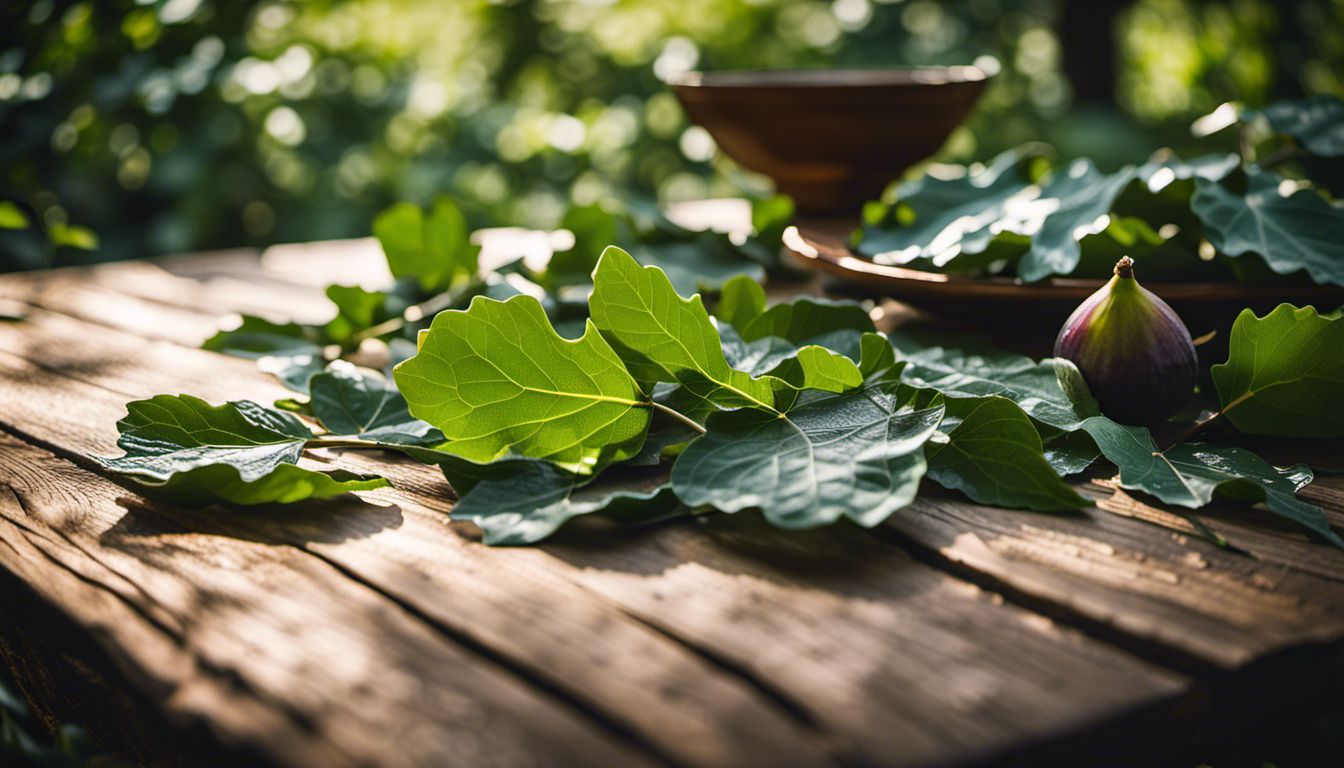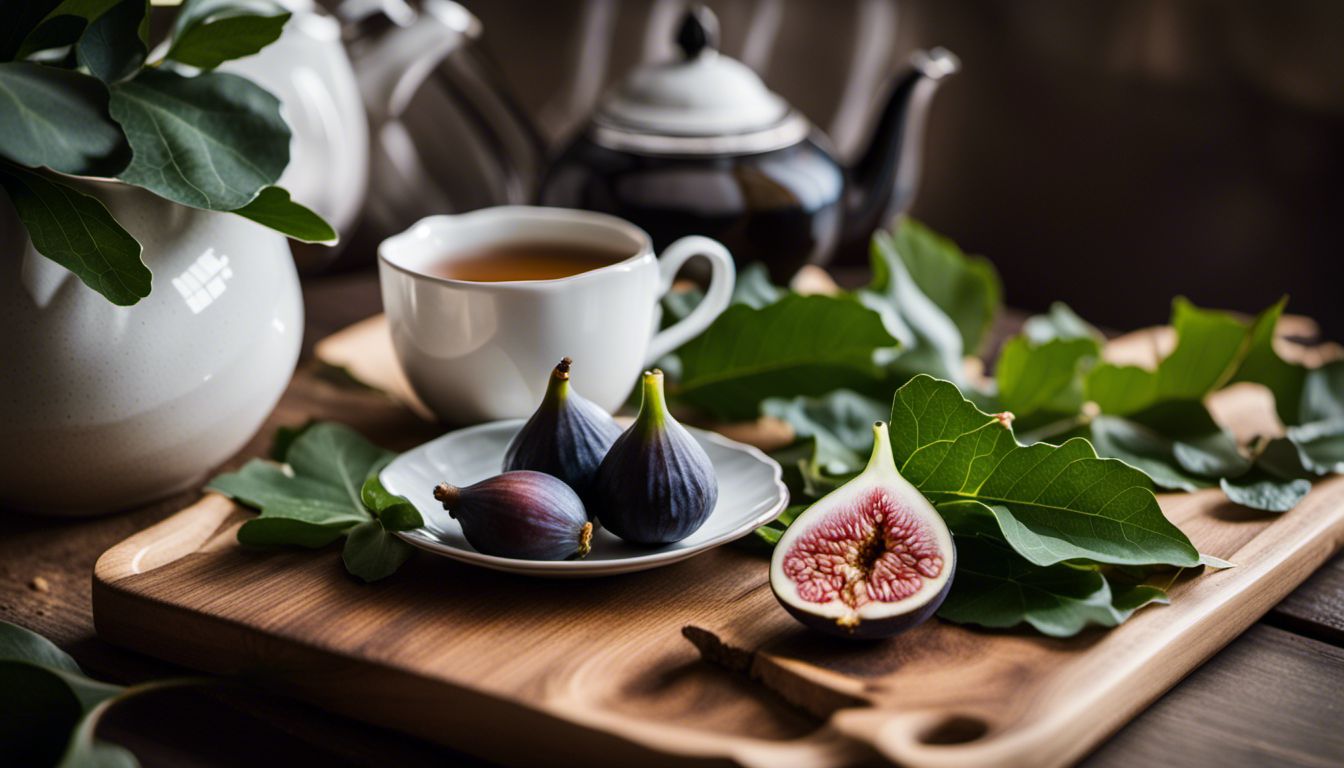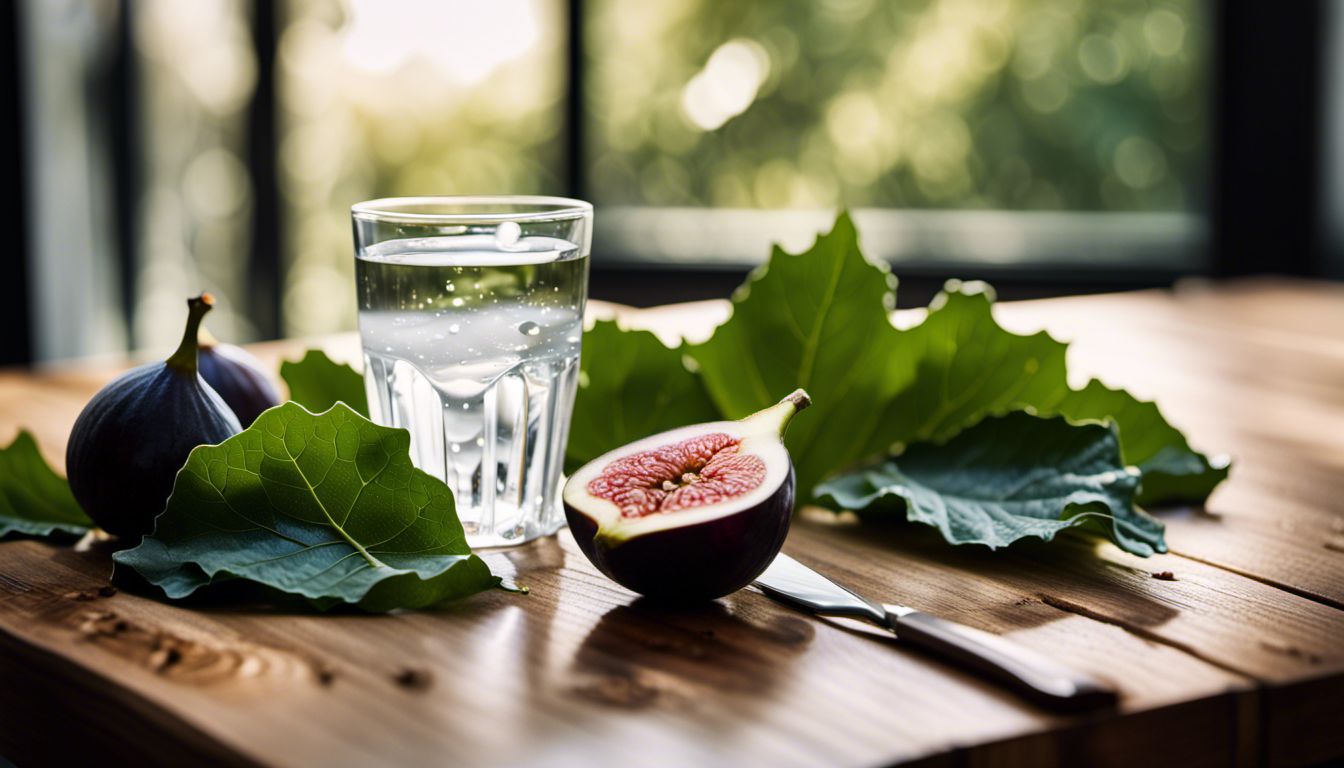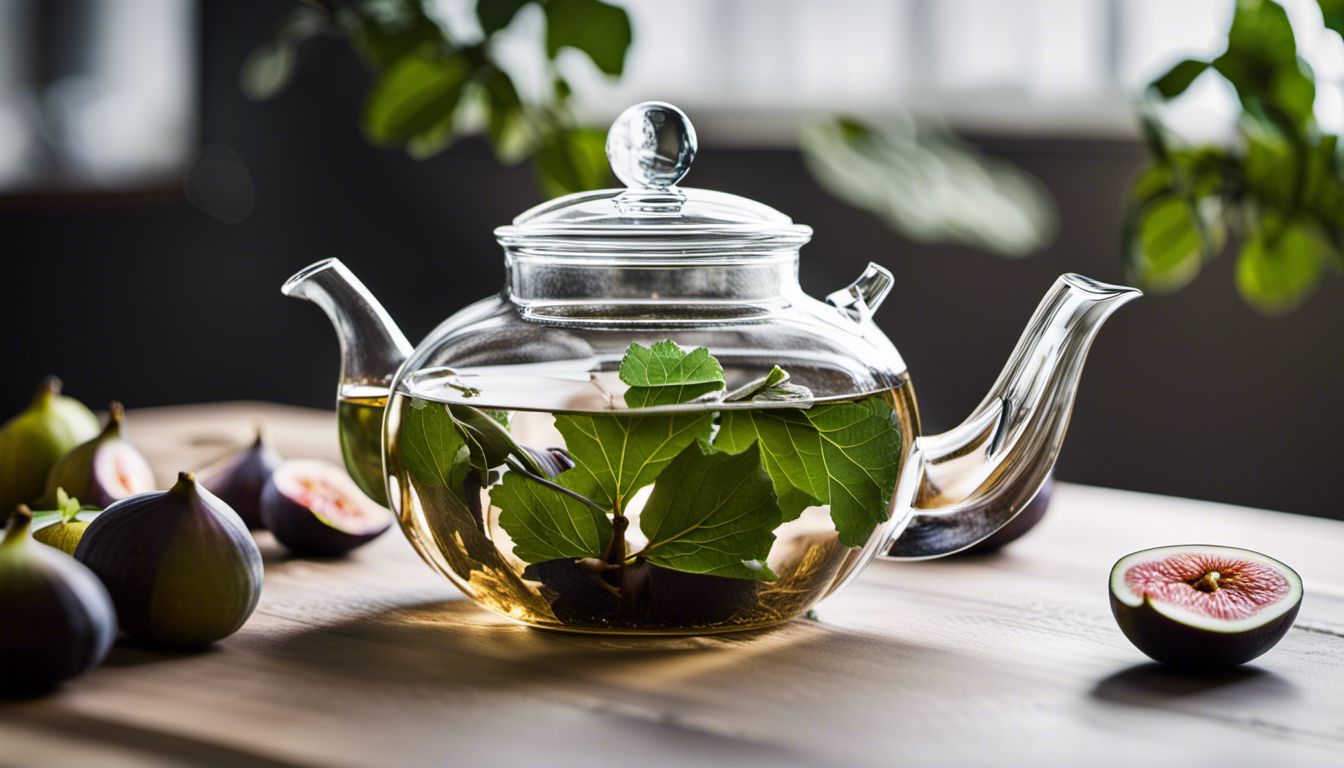How to make Fig Leaf Tea? Are you a tea enthusiast looking to explore new and exotic brews? Fig leaf tea is an underrated gem that’s not only refreshing but packed full of minerals and vitamins. This blog post aims to guide you through the simple process of making your own fig leaf tea at home, from gathering fresh leaves of the fig tree, right down to the brewing process.We’ll tell you about the various health benefits and the possible adverse effects.
Stay with us if you’re ready for a delicious journey into the delightful world of fig leaf tea!
Key Takeaways
- Harvest mature, dark green fig leaves from a pesticide-free tree in the morning for the best flavor.
- Dehydrate the leaves by air – drying them and then baking them at a low temperature until they are completely dry.
- Brew fig leaf tea by simmering fresh or dried leaves in boiling water for 10 – 15 minutes and then straining it before enjoying.
Harvesting and Preparing Fig Leaves for Tea

Foraging fresh fig leaves from a local tree or nursery is the first step in preparing fig leaf tea.
Foraging fresh fig leaves

Foraging fresh fig tree’s leaves is a relatively simple task. Choose leaves from the fig tree that are mature, dark green in color with no obvious blemishes or insect damage. Be sure to select trees that haven’t been sprayed with pesticides or other chemicals.
The best time for collection is early morning, when the leaves are still dew-kissed and full of flavor. Equipped with a basket and garden shears, snip off each leaf at its stem being careful not to tear the leaf or harm the tree’s branches.
After your harvest is complete, rinse each individual leaf under cold water to remove any surface dirt before using them in your tea preparation process.
Dehydrating the leaves

To dehydrate fig leaves for tea, follow these steps:
- Harvest fresh fig tea leaves from a healthy fig tree.
- Wash the leaves thoroughly to remove any dirt or debris.
- Lay the leaves out in a single layer on a clean kitchen towel or baking sheet.
- Allow the leaves to air dry for a few hours until they become slightly wilted.
- Preheat your oven to the lowest temperature setting (usually around 150°F or 65°C).
- Place the dry fig leaves on a baking sheet lined with parchment paper.
- Put the baking sheet in the oven and leave the door slightly open to allow moisture to escape.
- Let the leaves dehydrate in the oven for 2-3 hours, checking periodically to avoid over-drying them.
- Remove the baking sheet from the oven and let the leaves cool completely.
- Once cooled, store the dried fig leaves in an airtight container until ready to use.
Brewing the tea

To brew fig leaf tea, follow these simple steps:
- Bring water to a boil in a saucepan.
- Add a handful of fresh or dried fig leaves to the boiling water.
- Reduce the heat and let the leaves simmer for 10 – 15 minutes.
- Remove the saucepan from heat and let the tea steep for a few more minutes.
- Strain the fig leaf tea to remove any leaves or debris.
- Pour the brewed tea into your favorite mug or teapot.
- Enjoy your delicious and healthy cup of fig leaf tea.
Fig Leaf Tea Recipe

To make fig leaf tea, you will need fresh or dried fig leaves and water.
Ingredients needed

Step-by-step instructions

Here’s how to make fig leaf tea:
- Gather fresh or dried fig leaves.
- Bring a pot of water to a boil.
- Add a handful of fig leaves to the boiling water.
- Reduce the heat and let the leaves simmer for 10 – 15 minutes.
- Strain the tea to remove any leaf particles.
- Pour the fig leaf tea into your favorite cup or mug.
- Enjoy your homemade fig leaf tea with hot water or cold with ice cubes on a hot day.
Benefits of Fig Leaf Tea

Fig leaf tea offers potential health benefits due to its antioxidant properties and ability to promote digestion.
Potential health benefits of fig leaves

Fig leaf tea offers a range of potential health benefits that make it a great addition to your daily routine. This herbal infusion is packed with vitamins and minerals, such as B1, B2, A, phosphorus, manganese, potassium, sodium, iron, and calcium.
This natural remedy can support overall well-being and promote healthy bodily functions. Additionally, fig leaves have anti-diabetic properties that may help in managing diabetes and blood sugar levels, while needing less insulin.. With its delicious taste and numerous health benefits, fig leaf tea is a refreshing choice for those looking for a natural and nutritious beverage option.
Antioxidant properties

Fig leaf tea is not only delicious but also packed with good things like antioxidant properties. Antioxidants are substances that help protect our bodies from damage caused by harmful free radicals.
The fig leaves used to make the tea contain beneficial compounds such as polyphenols, flavonoids, and vitamins A and C, which act as antioxidants in our system. These antioxidants work to neutralize free radicals and reduce oxidative stress, helping to prevent chronic diseases, hart disease and promote overall health.
By enjoying a cup of fig leaf tea regularly, you can boost your antioxidant intake and support your body’s natural defense systems.
Promotes digestion

Fig leaf tea is not only a delicious and refreshing drink but also offers several health benefits, including promoting digestion. The natural compounds found in fig leaves can help improve digestive function and alleviate common digestive issues.
When consumed regularly, fig leaf tea can stimulate the production of digestive enzymes, which aids in the breakdown of food and enhances nutrient absorption. Additionally, fig leaf tea has mild laxative properties that can help prevent constipation and regulate bowel movements.also some studies say the tea has anti-inflammatory properties and can promote weight loss
This soothing herbal beverage can be a great addition to your daily routine to support healthy digestion and overall well-being.
Conclusion

In conclusion, making fig leaf tea is a simple and enjoyable process. Whether you choose to forage fresh leaves or use dried ones, the benefits of this herbal tea are numerous.
From its potential health benefits to its antioxidant properties, fig leaf tea is a delicious and refreshing way to enhance your wellness routine. So why not give it a try and experience the wonders of fig leaf tea for yourself? Cheers!
FAQs
1. How do I make fig leaf tea?
To make fig leaf tea, start by washing and drying fresh fig leaves. Then, tear the leaves into small pieces and place them in a teapot or mug. Pour boiling water over the leaves and let steep for about 5-10 minutes. Finally, strain out the leaves and enjoy your fig leaf tea.
2. Are there any fig leaf benefits to drinking fig leaf tea?
Fig leaf tea is believed to have a number of health benefits, including promoting digestion, reducing inflammation, it’s a good source of antioxidants, improving blood sugar control, and supporting liver health. However, it’s important to note that more research is needed to confirm these potential benefits.
3. Can I use dried fig leaves to make tea?
Yes, you can use dried fig leaves to make tea. Simply follow the same steps as using fresh leaves but adjust the steeping time slightly longer (around 10-15 minutes) since dried leaves may take longer to release their flavors.
4. Are there any precautions or side effects associated with drinking fig leaf tea?
While generally considered safe for most people when consumed in moderation, some individuals may experience an allergic reaction or digestive discomfort after consuming fig leaf tea. It’s always best to consult with a healthcare professional before adding any new herbal teas or supplements to your routine, especially if you have underlying medical conditions, undergoing medical treatments or are taking medications.
